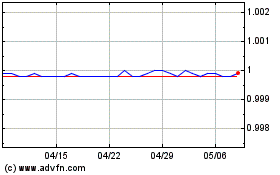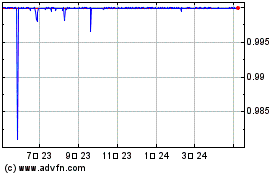RSK Is Transforming The Bitcoin Network Into A Go-To Destination For Stablecoins And DeFi
2022年4月11日 - 7:23PM
NEWSBTC
In recent years, stablecoins have become wildly popular throughout
the crypto universe due to their inherent feature that safeguards
investors from the volatility of the crypto market. They are used
for various use cases and exist across different blockchain
platforms. Until recently, stablecoins, decentralized finance
(DeFi), non-fungible tokens (NFTs), and other similar smart
contract-powered primitives weren’t available on the Bitcoin
network. However, with the emergence of RSK, the first smart
contract platform secured by the Bitcoin network, Bitcoin die-hards
can now access the limitless opportunities in DeFi, including
stablecoins, without needing to switch to another blockchain.
Bitcoin (BTC) is currently considered the most liquid
cryptocurrency in existence. It already has the largest market
capitalization and the largest user community. Accordingly, by
using BTC as collateral, stablecoins can leverage the inherent
features of the Bitcoin blockchain, which include decentralization,
censorship resistance, immutability, and unparalleled security.
Additionally, with BTC as collateral, the counterparty risks
associated with stablecoins can also be minimized to an extent.
RSK: A Goliath In The Making RSK is one of the platforms that level
the playing field for Bitcoin enthusiasts as open finance (OpFi)
continues to grow. There was a significant increase in the number
of users joining RSK’s smart contract ecosystem in 2021, sending
the amount of BTC pegged into RSK from 546 to 2,520 – a promising
development when considering that DeFi is still at its nascent
stage on the Bitcoin blockchain. To further expand its range of
DeFi services, RSK has also launched an interoperability bridge
with Ethereum, allowing a two-way transfer of any token between the
RSK and Ethereum ecosystems. As a result, Ethereum users can
seamlessly transact with rBTC, thus gaining indirect exposure to
the Bitcoin DeFi ecosystem. This bridge will also work in favor of
RSK users, especially those using Ethereum-based stablecoins such
as DAI. The Bitcoin DeFi movement is considered the next big leap
for DeFi 2.0. In this context, RSK, with its suite of stablecoins
and DeFi products, paired with the Bitcoin network’s time-tested
security and liquidity, has positioned itself as the go-to solution
for developers looking for alternatives to Ethereum’s rising
problems. On a technical level, RSK offers full EVM (Ethereum
Virtual Machine) compatibility, meaning developers can seamlessly
port their Solidity-based dApps (decentralized applications) to
Bitcoin without making any significant changes to the underlying
code. The two-way peg with Bitcoin enables developers to leverage
the features of both RSK and Bitcoin networks. When it comes to
scalability, Ethereum usually offers a throughput of 30 TPS
(transactions per second), which can go higher depending on the
network congestion. At the same time, RSK offers up to 100 TPS
without reducing storage space or compromising decentralization.
Likewise, in terms of gas fees, RSK charges as much as 42x lower
than the average gas fees of Ethereum. In terms of security, most
blockchain networks that follow the PoS (Proof-of-Stake) consensus
mechanism are prone to cyber attacks, as is evident from the recent
string of hacks across DeFi platforms. On the other hand, the
Bitcoin network ranks among the most secure because taking over the
Bitcoin network involves one party commanding at least 51% of the
hash rate. This is viewed as increasingly difficult as the hashrate
continues to rise. RSK is secured by around 50% of the total
hashrate of the Bitcoin network, which makes it the most secure
smart contract platform in terms of defending against 51% attacks.
Underlining the benefits of using stablecoins pegged with BTC,
Diego Gutierrez Zaldivar, Co-founder of RSK and CEO of IOVlabs,
explains, “Bitcoin is the most liquid crypto asset, and it’s
recognized as a store of value. Therefore I suppose it is the best
form of collateral that you can use in DeFi protocols. If you use a
stablecoin such as USDT, you’re prone to third-party risk. RSK’s
strength lies in a combination of features that we can potentially
achieve: top security, high decentralization, high scalability, and
low cost.” So far, the RSK ecosystem has amassed a TVL (Total Value
Locked) of more than $134 million, hosting some of the most
high-performing stablecoin projects like MoneyOnChain (MOC),
Sovryn, and BabelFish, among others. The Dollar on Chain (DoC)
stablecoin is among the primary assets offered by MoneyOnChain. It
is collateralized at a 1:1 ratio with BTC, positioning it among the
best collateral since BTC’s liquidity backs it. Then there’s the
RIF Dollar on Chain (RDOC), one of the primary assets offered by
the RIF On Chain DeFi platform. RDOC uses the RIF token as
collateral and is pegged at a 1:1 ratio with the US Dollar. The RSK
ecosystem is also home to XUSD, the USD-pegged stablecoin of the
cross-chain protocol BabelFish. The XUSD stablecoin is used as a
decentralized aggregator and distributor of multiple stablecoins
and can be exchanged or redeemed at a 1:1 ratio with any other
stablecoin as guaranteed by the underlying smart contract. With
RSK’s rDAI stablecoin emerging as an alternative to Ethereum’s high
transaction fees, you can convert DAI for much lower gas fees
(approximately 15 cents per transaction), making it about 80 times
cheaper than transacting DAI over the Ethereum network. Besides
these features, the RSK ecosystem is also home to the BRZ
stablecoin, which is pegged at 1:1 with the Brazilian Real (BRL).
On top of this, Blindex, a multi-currency stablecoin DeFi platform,
is also rolling out a wide range of stablecoins pegged to
individual assets utilizing RSK smart contracts. Commonly known as
BD-Stables, these stablecoins are pegged 1:1 with the underlying
currency. For instance, if a BD-Stable is pegged with USD, it is
represented as bUSD. For the Australian Dollar, it is bAUD, bEUR
for the Euro, bJPY for the Japanese Yen, and so forth. Thanks to
emerging technologies, the DeFi ecosystem has undergone several
transformations in the last couple of years. Stablecoins, as one of
the strongest pillars of the crypto market, will play a critical
role in the ongoing transition to DeFi 2.0, especially now as they
have finally found their way into the Bitcoin ecosystem, thanks to
RSK’s smart contract capabilities.
Dai Stablecoin (COIN:DAIUSD)
過去 株価チャート
から 3 2024 まで 4 2024

Dai Stablecoin (COIN:DAIUSD)
過去 株価チャート
から 4 2023 まで 4 2024
